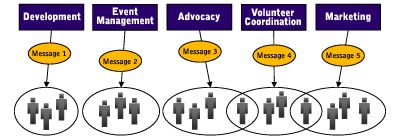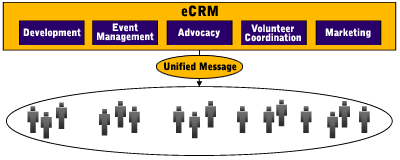|
Breaking Down the Silos: How eCRM Technology Can Help by Vinay Bhagat, Founder and Chief Strategy Officer, Convio
If you answered "yes" to any of these questions, you probably have an organizational silo problem. The functions within an organization look at the world largely through their own eyes. They communicate with their own constituent groups as if there were limited overlap between them, and in isolation from how other functions are communicating (see Fig. 1).
Fig. 1 - Constituent Communication in a Silo Organization While technology is by no means a panacea, an effective online constituent relationship management (eCRM) approach can help an organization break down functional silos and communicate with constituents in an integrated manner. The premise of eCRM is that the Internet is a shared resource for representing the face of an organization. It needs to appropriately balance all outward-facing constituent programs. The other key premise of eCRM is that a constituent might participate in more than one program and therefore should be communicated with in a unified fashion, with all of his/her interactions tracked in a single, consolidated database. A visual representation of an eCRM approach to communicating with constituents is illustrated in Fig. 2.
Fig. 2 - Constituent Communications Enabled by eCRM Organizations that have embraced an eCRM approach have more satisfied constituents, a more complete view of their constituents' interests and support levels, and are able to grow their support levels across functions. A great example of an organization like this is the Chesapeake Bay Foundation. The foundation uses Convio as its enterprise-wide eCRM system. Convio powers the group's Web site, email communications, online fundraising and advocacy. Thirty people across the organization in different functions use the system. A single, central point person is responsible for overall direction and content. Prior to implementing Convio, the foundation used stand-alone systems for online content management, advocacy and fundraising. Since switching to Convio, the group has been able to grow its email list substantially, increase participation levels in advocacy and fundraising and communicate more consistently with constituents. The eCRM implementation also has enabled the organization to make headway in breaking down functional silos. Federated nonprofit organizations such as Easter Seals, too, have been able to reap significant benefits from an eCRM approach. In the last three years, Easter Seals has successfully implemented a network-wide eCRM system that tracks all online constituent interactions across affiliates in a single database. All business functions at the national office and close to 90 percent of the organization's affiliates have embraced the system. Constituents now are benefiting from a more uniform and consistent communications experience. In addition, the Easter Seals network has increased capacity because the national office provides regular, sustained constituent communications in instances where affiliates do not have the resources to do so. Online fundraising has grown substantially year-to-year and the organization has found it easier to enforce branding standards. Although most nonprofits operate as a collection of departments or functions, without sharing constituent data or coordinating constituent communications, it does not have to be that way. eCRM is proving to be an effective approach to breaking down silos and organizing communications and program outreach around the constituent, producing a better experience for an organization's supporters. Have a colleague who might be interested in this topic? Why not forward this article?
|
|


 Ask yourself the following questions:
Ask yourself the following questions:


